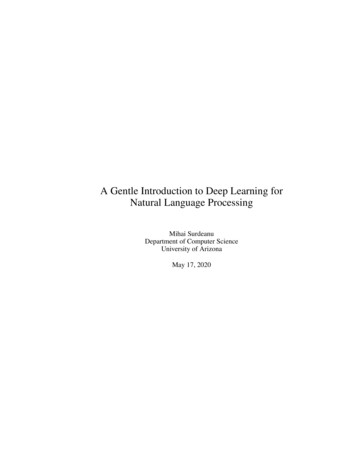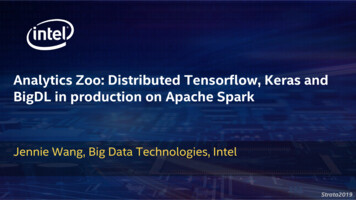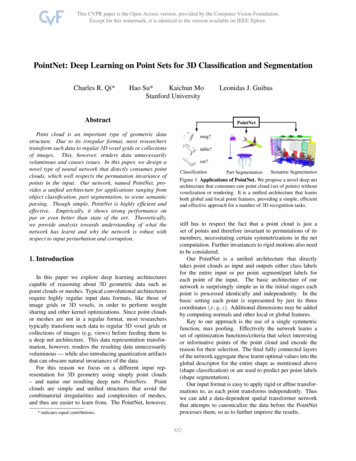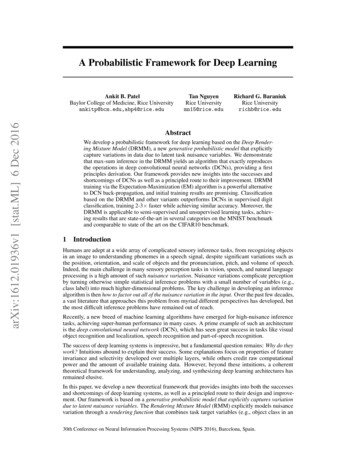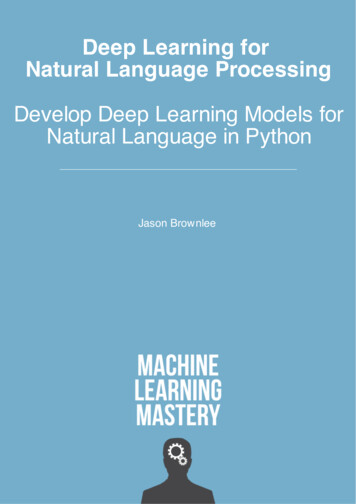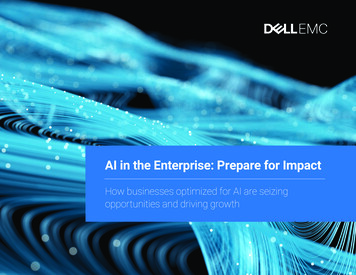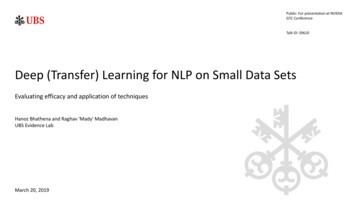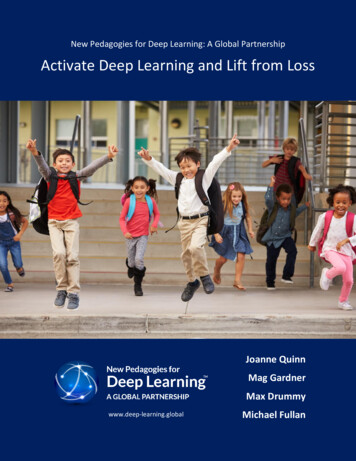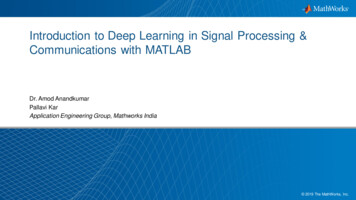
Transcription
Introduction to Deep Learning in Signal Processing &Communications with MATLABDr. Amod AnandkumarPallavi KarApplication Engineering Group, Mathworks India 2019 The MathWorks, Inc.1
Different Types of Machine LearningType of Machine LearningCategories of AlgorithmsClassification Output is a choice between classes(True, False) (Red, Blue, Green)SupervisedLearningMachineLearningDevelop predictivemodel based on bothinput and output dataUnsupervisedLearningRegressionClustering Output is a real number(temperature, stock prices) No output - find natural groups andpatterns from input data onlyDiscover an internalrepresentation frominput data only2
What is Deep Learning?3
Deep learning is a type of supervised machine learning in which amodel learns to perform classification tasks directly from images, text,or sound.Deep learning is usually implemented using a neural network.The term “deep” refers to the number of layers in the network—themore layers, the deeper the network.4
Why is Deep Learning So Popular Now?HumanAccuracySource: ILSVRC Top-5 Error on ImageNet5
Vision applications have been driving the progress in deep learningproducing surprisingly accurate systems6
Deep Learning success enabled by: Labeled public datasets Progress in GPU for acceleration World-class models andconnected ETRAINED MODELTensorFlowKerasIMPORTERONNX ConverterMODEL CONVERTERInception-v3MODELS7
Deep Learning is VersatileMATLAB Examples Available Here8
Many Network Architectures for Deep LearningSeries NetworkDirected AcyclicGraph NetworkRecurrent Networkand more(GAN, DQN, )AlexNetYOLOResNetR-CNNLSTM9
Convolutional Neural NetworksEdgesShapesObjectsA lot of datais requiredConvolution layersFully-connectedlayers10
Deep Learning Inference in 4 Lines of Code net alexnet; I imread('peacock.jpg') I1 imresize(I,[227 227]); classify(net,I1) ans categoricalpeacock11
Understanding network behavior using visualizationsFilters Deep DreamActivations Custom visualizations– Example: Class Activation Maps(See blog post)12
Visualization Technique – Deep DreamdeepDreamImage(.net, ‘fc8', channel,'NumIterations', 50, .'PyramidLevels', 4,.'PyramidScale', 1.25);Synthesizes images that strongly activatea channel in a particular layerExample Available Here13
What is Training?ImagesNetworkTrainingLabelsLarge Data SetTrained DeepNeural NetworkDuring training, neural network architectures learn features directlyfrom the data without the need for manual feature extraction14
What Happens During Training?AlexNet ExampleLabelsTraining DataLayer weights are learnedduring training15
Visualize Network Weights During TrainingAlexNet ExampleLabelsTraining DataFirst ConvolutionLayer16
Visualize Features Learned During TrainingAlexNet ExampleSample Training DataFeatures Learned by Network17
Visualize Features Learned During TrainingAlexNet ExampleSample Training DataFeatures Learned by Network18
Deep Learning WorkflowACCESS AND EXPLOREDATALABEL AND PREPROCESSDATADEVELOP PREDICTIVEMODELSINTEGRATE MODELS WITHSYSTEMSFilesData iningDesktop AppsDatabasesLabeling AutomationHyperparameter TuningEnterprise Scale SystemsSensorsImport ReferenceModelsNetwork VisualizationEmbedded Devices andHardware19
Deep Learning ChallengesData Handling large amounts of data Labeling thousands of signals, images & videos Transforming, generating, and augmenting data (for different domains)Training and Testing Deep Neural Networks Accessing reference models from research Understanding network behaviour Optimizing hyperparameters Training takes hours-daysRapid and Optimized Deployment Desktop, web, cloud, and embedded hardware20
Working with Signal ormFully ConnectedLayersTrainConvolutionalNetwork (CNN)Trained ModelTrained Model21
Long Short Term Memory Networks from RNNs Recurrent Neural Network that carries a memory cell throughout the processSequence Problems – Long term dependency does not work well with RNNsc0C1Ct22
RNN to LSTMCell stateInput gateForget gateUpdateOutput gate23
Example: Speaker Gender Recognition Using Deep LearningLSTM Network for Audio based Speaker ClassificationaudioDatastoreTraining Data1. TrainMozilla CommonVoice Dataset Male FemaleTime-varyingfeatures:- MFCC- Pitch- .Test Data2. Predict Male Female24
Some audio and speech applications following CNN workflows27
https://www.isca-speech.org/archive/interspeech 2015/papers/i15 1478.pdf28
Solution2: Speech Command Recognition with Deep Learning(MATLAB)Raw DataPreprocessedDataModels and AlgorithmsIntegrated AnalyticSystems.29
43
44
45
46
Data augmentation allows training more advanced networks andgenerating more robust modelsOriginalDatasetSimulate:-lower voicevarying level of environmental interferencerecording hardware effectsdistortions due to use of different microphonesdifferent speaker vs microphone positions or room sizes inenclosed environments.50
Serial% Cycle continuously and automatically through files in datastoremfccFile zeros(numel(ads.Files),numMfcc)while hasdata(ads)[data,info] read(ads);% do something with dataendParallel% Partition and explicit parfor parallel processing patternN numpartitions(ads);parfor index 1:Nsubads partition(ads,N,index);while hasdata(subads)data read(subads);% do something with dataendend% Tall array and "implicit" parallel processing patternT tall(ads);dcOffsets cellfun(@(x) mean(x), T,'UniformOutput',false);gather(dcOffsets);51
Package Speech Recognition App52
53
BREAK54
Deep Learning ChallengesDataNot a deep learning expert Handling large amounts of data Labeling thousands of signals, images & videos Transforming, generating, and augmenting data (for different domains)Training and Testing Deep Neural Networks Understanding network behavior Accessing reference models from research Optimizing hyperparameters Training takes hours-daysRapid and Optimized Deployment Desktop, web, cloud, and embedded hardware55
BREAK56
57
Speech 2 text intro58
59
60
61
62
Audio Labeler Work on collections ofrecordings or record new audiodirectly within the app Navigate dataset and playbackinteractively Define and apply labels to– Entire files– Regions within files Import and export audio folders,label definitions and datastores63
Apps for Data Labeling64
Label Images Using Image Labeler App65
Accelerate Labeling With Automation AlgorithmsLearn More66
Perform Bootstrapping to Label Large DatasetsImagesVideosTrainNetworkLabeling AppsImproveNetworkMoreGround TruthGround TruthPropose LabelsAutomationAlgorithm67
Example – Semantic Segmentation Available HereClassify pixels into 11 classes– Sky, Building, Pole, Road,Pavement, Tree, SignSymbol,Fence, Car, Pedestrian, Bicyclist CamVid datasetBrostow, Gabriel J., Julien Fauqueur, and Roberto Cipolla. "Semantic object classes invideo: A high-definition ground truth database." Pattern Recognition Letters Vol 30, Issue2, 2009, pp 88-97.68
Example: Singing Voice Separation Source separationBased on U-Net architecture69
Synthetically generating labeled data70
Modulation Classification with Deep Learning Generate synthetic modulated signals Apply channel impairments Train a CNN to classify modulation types71
Deep Learning ChallengesData Handling large amounts of data Labeling thousands of signals, images & videos Transforming, generating, and augmenting data (for different domains)Training and Testing Deep Neural Networks Understanding network behavior Accessing reference models from research Optimizing hyperparameters Training takes hours-daysRapid and Optimized Deployment Desktop, web, cloud, and embedded hardware72
Transfer Learning8 lines of MATLAB CodeLoad Training Data12Load Pre-TrainedNetwork345Replace Final Layers6Train Network onNew Data78%% Create a datastoreimds e,'LabelSource','foldernames');num classes numel(unique(imds.Labels));%% Load Referece Networknet alexnet;layers net.Layers%% Replace Final Layerslayers(end-2) fullyConnectedLayer(num classes,'Name',[‘fc5']);layers(end) classificationLayer('Name','classOut');%% Set Training Options & Train NetworktrainOpts trainingOptions('sgdm’,.'MiniBatchSize', 64);net trainNetwork(imds, layers, trainOpts);73
Tune Hyperparameters to Improve TrainingMany hyperparameters depth, layers, solver options,learning rates, regularization, Techniques Parameter sweep Bayesian optimization74
Keras-Tensorflow Importer75
Model Exchange and Co-executionMATLABModel ExchangePythonCo-execution76
Model Exchange With Deep Learning re MLChainerCognitiveToolkitTensorFlowKerasCaffeONNX Open Neural Network Exchange Format77
Interoperate With Deep Learning Frameworks – Use itVisualizationandDebuggingImportCore MLChainerONNX Open Neural Network Exchange Format78
Model Exchange With Deep Learning FrameworksCaffe Model Importer importCaffeLayers importCaffeNetworkTensorFlow-Keras Model Importer importKerasLayers importKerasNetworkONNX Converter importONNXNetwork exportONNXNetworkONNX Converter79
Model Exchange and Co-executionMATLABPythonModel ExchangeCo-execution80
MATLAB-Python Co-Execution – The ‘How’Call Python file fromMATLABCall TensorFlow commands fromMATLABTF code.py81
MATLAB-Python Co-Execution – Method A1.2.Copy the code into a .PY fileWrap entry point in a functionimport tensorflow as tffrom tf import kerasdef myTFCode():for x in y:a.foo()def foo(x):return x 1TF code.py3.Add module to Python path and then callfrom MATLAB via:py.myModule.myTFCode();82
Deep Learning on CPU, GPU, Multi-GPU and ClustersH O W T O TA R G E T ?SingleCPUSingle CPUSingle GPUSingle CPU, Multiple GPUsOn-prem server withGPUsCloud GPUs(AWS)83
MATLAB Containers for NVIDIA GPU Cloud & DGX84
Deep Learning ChallengesData Handling large amounts of data Labeling thousands of signals, images & videos Transforming, generating, and augmenting data (for different domains)Training and Testing Deep Neural Networks Accessing reference models from research Understanding network behaviour Optimizing hyperparameters Training takes hours-daysRapid and Optimized Deployment Desktop, web, cloud, and embedded hardware85
Deploying Deep Learning ApplicationEmbedded HardwareCodeGenerationApplicationlogicDesktop, Web, CloudApplicationDeployment86
MATLAB Production Server is an application server that publishesMATLAB code as APIs that can be called by other applicationsAnalytics DevelopmentMATLABCompiler SDKPackageMATLABDeployCode / testAccessEnterpriseApplicationIntegrateMATLAB Production ServerData sources /applicationsWorker processes RequestBrokerScale and secureMobile / WebApplication3rd partydashboard87
MATLAB support for Cloud88
89
IAAS to PAAS90
Automatic Cluster Creation91
Get Public IP for access92
Server Machine VM access MPS console endpoint: https://xxx.xx.xx.xx93
Deploying Deep Learning ApplicationEmbedded HardwareCodeGenerationApplicationlogicDesktop, Web, CloudApplicationDeployment94
Solution- GPU/MATLAB Coder for Deep Learning DeploymentTarget LibrariesGPU CoderApplicationlogicTensorRT mputeLibrary95
Deep Learning Deployment WorkflowsINFERENCE ENGINE DEPLOYMENTTrainedDNNINTEGRATED APPLICATION DEPLOYMENTPreprocessingcnncodegenPortable target codePostprocessingcodegenPortable target code96
Single Image Inference on Titan Xp using cuDNNTensorFlowMXNet(1.2.1)GPU CoderPyTorchIntel Xeon CPU 3.6 GHz - NVIDIA libraries: CUDA9 - cuDNN 7(1.8.0)(R2018b)(0.3.1)97
NVIDIA Hardware Support Package (HSP)Simple out-of-box targeting for NVIDIA boards:INFERENCE ENGINE DEPLOYMENTJetsonDrive platformTrainedDNNcnncodegenPortable target code98
Summary- MATLAB Deep Learning FrameworkDEPLOYMENTIntelMKL-DNNLibraryAccess Data Manage large image sets Automate image labeling Easy access to modelsDesign Train Acceleration with GPU’sScale to clustersNVIDIATensorRT &cuDNNLibrariesARMComputeLibrary99
Summary Create and validate Deep learning models Automate ground truth labeling Access large amount of data from cluster/cloud Interoperability with Deep learningframeworks Visualization and hyperparameter tuning Seamlessly scale training to GPUs, clusters and cloud Deployment on embedded targets and web services100
Available Here 101
102
103
4 Deep learning is a type of supervised machine learning in which a model learns to perform classification tasks directly from images, text, or sound. Deep learning is usually implemented using a neural network. The term “deep” refers to the number of layer
